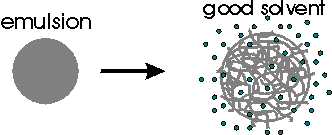Colloids
Colloidal Dispersions
Colloids are particles wihin a size range from few nanometers up to some microns, that show a phase separation to the surrounding medium. Colloidal systems exist between all possible states of aggregation: for example solid-gas (aerosols) or fluid-fluid (emulsions). Its common to all colloidal systems, that there is one phase dispered in the other phase. Therefore even biological systems (cells) are of colloidal nature.

We examine polymer colloids that are being synthesised in emulsion polymerisation. They are spherical micronetworks that swell, once put in a good organic solvent, to radii of 50 up to 500 nm. The "hairy" surface of these networks leads to a repulsive interaction potential (sterical stabilisation).
The structure and dynamics of such colloids can be described with a "hard sphere" potential, that is being found in atomic systems. But because of the larger size and the greater mass the dynamics of micronetwork polymers is observable on much longer length and time scales.
They are ideal systems for studies with light scattering techniques as dynamic or static light scattering.
If the size distribution is rather narrow, micronetwork colloids can even form crystals.
The structure and dynamics of such colloids can be described with a "hard sphere" potential, that is being found in atomic systems. But because of the larger size and the greater mass the dynamics of micronetwork polymers is observable on much longer length and time scales.
They are ideal systems for studies with light scattering techniques as dynamic or static light scattering.
If the size distribution is rather narrow, micronetwork colloids can even form crystals.

